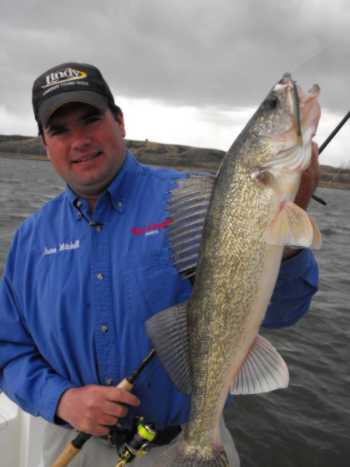| The affect of wind on walleye is almost cliché.
Follow the wind or fish the windy shore. Wind stacks up baitfish
and then the walleye follow. The reality is however that this
cliché is only right half the time so this theory is
just another half truth. There are so many scenarios where wind
has a negative affect on walleye location and movements. There
are many times where we are more productive avoiding the wind
and the more we can recognize just when wind is not good for
our fishing efforts, the better anglers we can become.
 |
One obvious scenario where wind can shut down a pattern
is when wind can push cold water into an area, cooling
down the water temperature by several degrees. Another
bad situation is when strong winds can muddy up the water
to the point where visibility is limited. There are many
instances where strong wind can shut down a bite and the
best policy is to avoid the areas getting hit hardest
by wind.Wind really seems to have a drastic affect on
fish location and movements. The extreme of these effects
varies somewhat by our own ability to make adjustments.
One location or situation where wind can move fish drastically
are fish relating to weed beds.Wave action that is intense
enough to move underwater vegetation really causes fish
to either push up, out or in. What push up, out or in
means is that fish will often ride above the weed bed
if possible, move inside between the weed bed and the
shoreline or suspend off the outside edge when wind kicks
up. |
The reason being is that walleye just seem to not like stuff
bumping or touching them. If weeds are blowing around, they
pull out.
Another consideration with wind, the undertow or reverse
current caused by intense wave action is generally about the
same height as the wave. In other words, three foot waves
often seem to accompany an additional three foot depth of
pretty strong undertow. In other words, four foot rollers
really mean that the top eight feet of the water column are
getting mixed up pretty intensely. Often, with an intense
wave action and corresponding undertow, walleye often seem
to avoid the wrath and drop just below the current. This is
just a general starting point, four foot rollers generally
means that the top eight feet of the water column is getting
shook up, nine to eight feet would be a good starting point
to look for fish. Here is another rule of thumb, fish that
are big, larger than about four or five pounds are much more
likely to move right into the undertow. But, fish in general
seem to dodge below it, as you will seldom find walleye that
wash up on shore even during the strongest storms or gale
force winds. Ironically, walleyes often move much shallower
after the wind recedes and the water is still stirred up.
Thus we might find fish in a foot of water when the weather
is actually calm but in essence, we are fishing “yesterday’s
wind.”
When wind is constant and moderate, many of these fish movements
are somewhat predictable. When dealing with walleyes relating
to weeds, fish the water above the weeds or move inside or
outside the weed bed depending on the velocity of the wind.
The more intense the wind and wave action is however, the
more unpredictable walleyes can become. Too much wind can
move fish right out of the area completely. As much as we
like a walleye chop or some wind, actually seeking out areas
getting hit by wind, we probably spend just as much time trying
to avoid the wind, finding bays and shorelines that are protected
from the wrath. Blindly following wind or fishing windblown
shorelines and structure will not automatically account for
more walleye. There is much more to understanding the affect
of how wind dictates walleye location.
Understanding the negative affects that strong wind often
has will help you pick locations that are relatively stable
or protected. Fishing the “calm side” is often
much more productive than many walleye anglers imagine.
|

